fuel pressure HONDA CIVIC HATCHBACK 2019 Owner's Manual (in English)
[x] Cancel search | Manufacturer: HONDA, Model Year: 2019, Model line: CIVIC HATCHBACK, Model: HONDA CIVIC HATCHBACK 2019Pages: 699, PDF Size: 35.16 MB
Page 13 of 699

11
Quick Reference Guide
Instrument Panel (P 77)
System Indicators
Malfunction Indicator
Lamp
Charging System
IndicatorAnti-lock Brake
System (
ABS)
Indicator
Vehicle Stability
Assist® (VSA®) System
Indicator
Vehicle Stability
Assist® (VSA®) OFF
Indicator
Low Tire Pressure/
TPMS Indicator
*
Electric Power
Steering (EPS) System
Indicator Seat Belt Reminder
Indicator
System Indicators
Parking Brake and
Brake System
Indicator (Red) Supplemental
Restraint System
Indicator
Tachometer
Immobilizer System Indicator/
Security System Alarm Indicator
Shift Lever
Position Indicator
*
Low Fuel Indicator
ECON Mode Indicator
*
Turn Signal and
Hazard Warning
Indicators
Parking Brake and
Brake System
Indicator (Amber)
System Indicators
U.S.
Canada
U.S.
Canada Automatic
Brake Hold
System Indicator
Automatic Brake
Hold IndicatorU.S.
Canada
Temperature
Gauge
Lights Indicators
Lights On Indicator
High Beam Indicator
Fog Light Indicator*
Adaptive Cruise
Control (ACC) with
Low Speed Follow
(LSF)
* Indicator
(Amber/Green)*
System Message
Indicator
Collision Mitigation
Braking System
TM
(CMBSTM) Indicator*
Road Departure
Mitigation (RDM)
Indicator
*
Lane Keeping Assist
System (LKAS)
Indicator (Amber/
Green)
*
M (7-speed manual shift mode)
Indicator/Shift Indicator*
Auto High-Beam
Indicator*
Shift Up/Down
Indicator*
Drive Mode Indicator*
Speedometer Fuel Gauge
Gear Position Indicator*
Gauges (P 117)/Driver Informat
ion Interface (P 119)/System Indicators (P 78)
Low Oil Pressure
Indicator
* Not available on all models
19 CIVIC 5D HUM (KA KC KL)-31TGG6201.book 11 ページ 2018年10月25日 木曜日 午後4時12分
Page 26 of 699
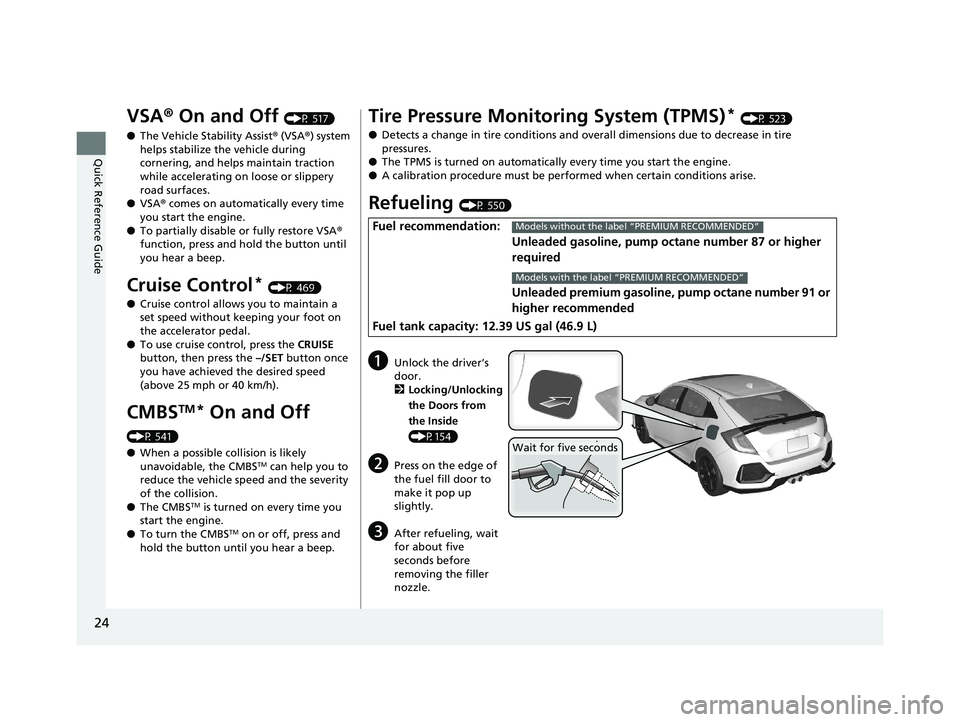
24
Quick Reference Guide
VSA® On and Off (P 517)
● The Vehicle Stability Assist ® (VSA ®) system
helps stabilize the vehicle during
cornering, and helps maintain traction
while accelerating on loose or slippery
road surfaces.
● VSA ® comes on automatically every time
you start the engine.
● To partially disable or fully restore VSA ®
function, press and ho ld the button until
you hear a beep.
Cruise Control* (P 469)
● Cruise control allows you to maintain a
set speed without keeping your foot on
the accelerator pedal.
● To use cruise control, press the CRUISE
button, then press the –/SET button once
you have achieved the desired speed
(above 25 mph or 40 km/h).
CMBSTM* On and Off
(P 541)
● When a possible collision is likely
unavoidable, the CMBS
TM can help you to
reduce the vehicle sp eed and the severity
of the collision.
● The CMBS
TM is turned on every time you
start the engine.
● To turn the CMBS
TM on or off, press and
hold the button until you hear a beep.
Tire Pressure Monitoring System (TPMS)* (P 523)
● Detects a change in tire conditions and overall dimensions due to decrease in tire
pressures.
● The TPMS is turned on automatically every time you start the engine.
● A calibration procedure must be performed when certain conditions arise.
Refueling (P 550)
Fuel recommendation:
Unleaded gasoline, pump octane number 87 or higher
required
Unleaded premium gasoline, pump octane number 91 or
higher recommended
Fuel tank capacity: 12.39 US gal (46.9 L)Models without the label “PREMIUM RECOMMENDED”
Models with the label “PREMIUM RECOMMENDED”
aUnlock the driver’s
door.
2 Locking/Unlocking
the Doors from
the Inside
(P154)
bPress on the edge of
the fuel fill door to
make it pop up
slightly.
cAfter refueling, wait
for about five
seconds before
removing the filler
nozzle.
Wait for five seconds
19 CIVIC 5D HUM (KA KC KL)-31TGG6201.book 24 ページ 2018年10月25日 木曜日 午後4時12分
Page 123 of 699

121
uuGauges and Driver Information Interface uDriver Information Interface
Continued
Instrument Panel
*1:You can add the contents using the audio/information screen.
Accelerator
Position/Braking
Pressure Meter Turbo Meter Rev Indicators G-Meter Stopwatch Range &
Fuel
Phone
Speed Unit &
Disp OFF
Warning
Messages
Average Speed
& Elapsed Time
Mail
*
Optional contents*1:
2.0 L engine models
Navigation*
& Compass*
Audio Customize*Maintenance
MinderTMPress , ,
or .
Press ENTER .
(Display/
Information) Button
* Not available on all models
19 CIVIC 5D HUM (KA KC KL)-31TGG6201.book 121 ページ 2018年10月25日 木曜日 午後4時12分
Page 126 of 699
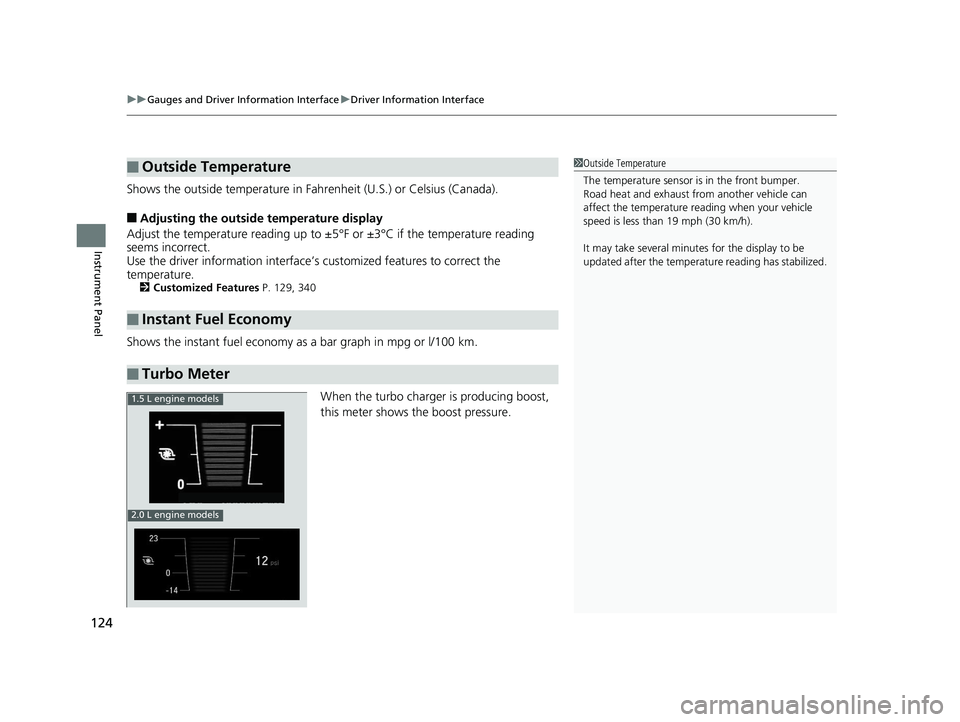
uuGauges and Driver Information Interface uDriver Information Interface
124
Instrument Panel
Shows the outside temperature in Fahr enheit (U.S.) or Celsius (Canada).
■Adjusting the outside temperature display
Adjust the temperature reading up to ±5°F or ±3°C if the temperature reading
seems incorrect.
Use the driver information interface’s customized features to correct the
temperature.
2 Customized Features P. 129, 340
Shows the instant fuel economy as a bar graph in mpg or l/100 km.
When the turbo charger is producing boost,
this meter shows th e boost pressure.
■Outside Temperature
■Instant Fuel Economy
■Turbo Meter
1Outside Temperature
The temperature sensor is in the front bumper.
Road heat and exhaust from another vehicle can
affect the temperature reading when your vehicle
speed is less than 19 mph (30 km/h).
It may take several minutes for the display to be
updated after the temperature reading has stabilized.
1.5 L engine models
2.0 L engine models
19 CIVIC 5D HUM (KA KC KL)-31TGG6201.book 124 ページ 2018年10月25日 木曜日 午後4時12分
Page 439 of 699
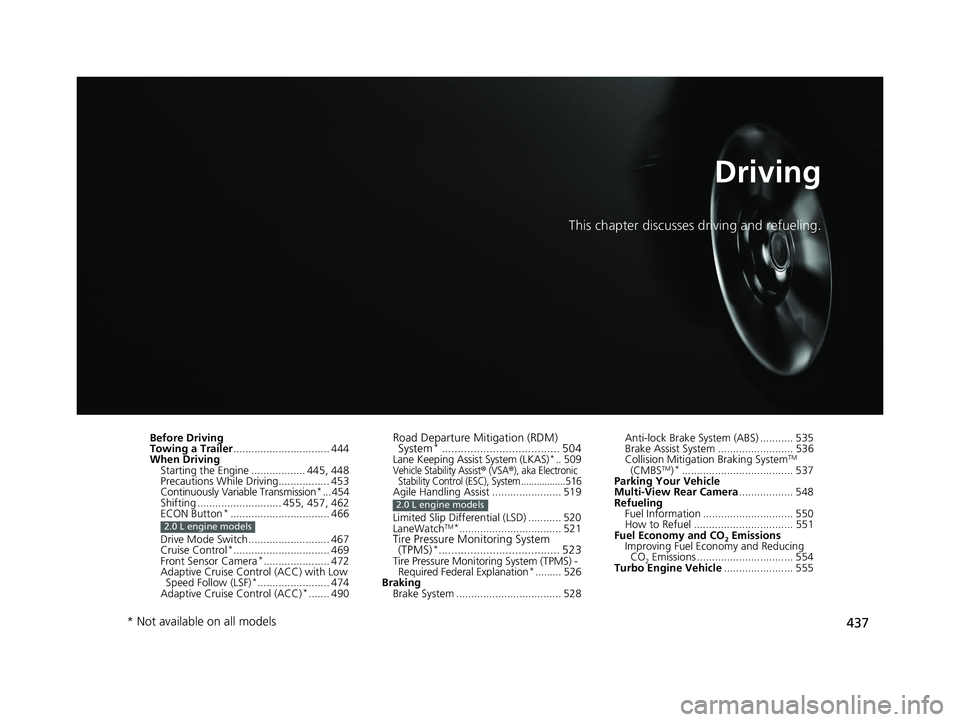
437
Driving
This chapter discusses driving and refueling.
Before Driving
Towing a Trailer................................ 444
When Driving
Starting the Engine .................. 445, 448
Precautions While Driving................. 453
Continuously Variable Transmission
*... 454
Shifting ............................ 455, 457, 462
ECON Button
*................................. 466
Drive Mode Switch ........................... 467
Cruise Control
*................................ 469
Front Sensor Camera*...................... 472
Adaptive Cruise Control (ACC) with Low Speed Follow (LSF)
*........................ 474
Adaptive Cruise Control (ACC)*....... 490
2.0 L engine models
Road Departure Mitigation (RDM) System*..................................... 504Lane Keeping Assist System (LKAS)*.. 509Vehicle Stability Assist® (VSA®), aka Electronic
Stability Control (ESC), System ................. 516
Agile Handling Assist ....................... 519
Limited Slip Differential (LSD) ........... 520
LaneWatch
TM*.................................. 521Tire Pressure Monitoring System (TPMS)*...................................... 523Tire Pressure Monitoring System (TPMS) -
Required Federal Explanation*......... 526
Braking Brake System ................................... 528
2.0 L engine models
Anti-lock Brake System (ABS) ........... 535
Brake Assist System ......................... 536
Collision Mitigation Braking System
TM
(CMBSTM)*..................................... 537
Parking Your Vehicle
Multi-View Rear Camera .................. 548
Refueling Fuel Information .............................. 550
How to Refuel ................................. 551
Fuel Economy and CO
2 Emissions
Improving Fuel Economy and Reducing CO
2 Emissions ................................ 554
Turbo Engine Vehicle ....................... 555
* Not available on all models
19 CIVIC 5D HUM (KA KC KL)-31TGG6201.book 437 ページ 2018年10月25日 木曜日 午後4時12分
Page 528 of 699
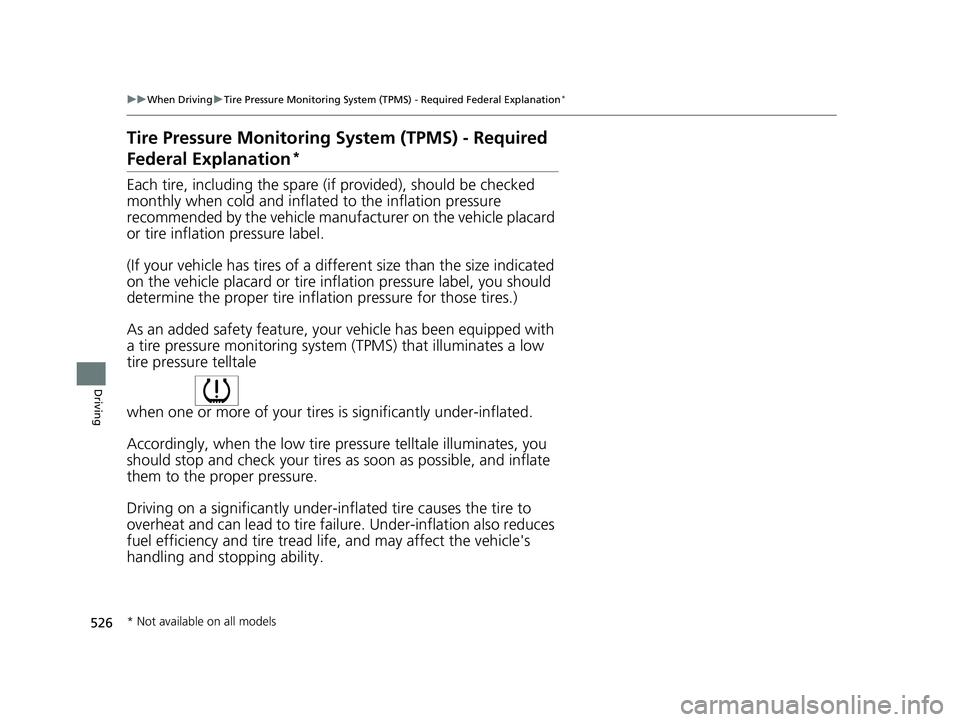
526
uuWhen Driving uTire Pressure Monitoring System (TPMS) - Required Federal Explanation*
Driving
Tire Pressure Monitoring System (TPMS) - Required
Federal Explanation*
Each tire, including the spare (i f provided), should be checked
monthly when cold and inflated to the inflation pressure
recommended by the vehicle manufacturer on the vehicle placard
or tire inflation pressure label.
(If your vehicle has tires of a different size than the size indicated
on the vehicle placard or tire infl ation pressure label, you should
determine the proper tire inflat ion pressure for those tires.)
As an added safety feature, your vehicle has been equipped with
a tire pressure monitoring system (TPMS) that illuminates a low
tire pressure telltale
when one or more of your tire s is significantly under-inflated.
Accordingly, when the low tire pr essure telltale illuminates, you
should stop and check your tires as soon as possible, and inflate
them to the proper pressure.
Driving on a significantly under-in flated tire causes the tire to
overheat and can lead to tire failure. Under-inflat ion also reduces
fuel efficiency and tire tread li fe, and may affect the vehicle's
handling and stopping ability.
* Not available on all models
19 CIVIC 5D HUM (KA KC KL)-31TGG6201.book 526 ページ 2018年10月25日 木曜日 午後4時12分
Page 556 of 699
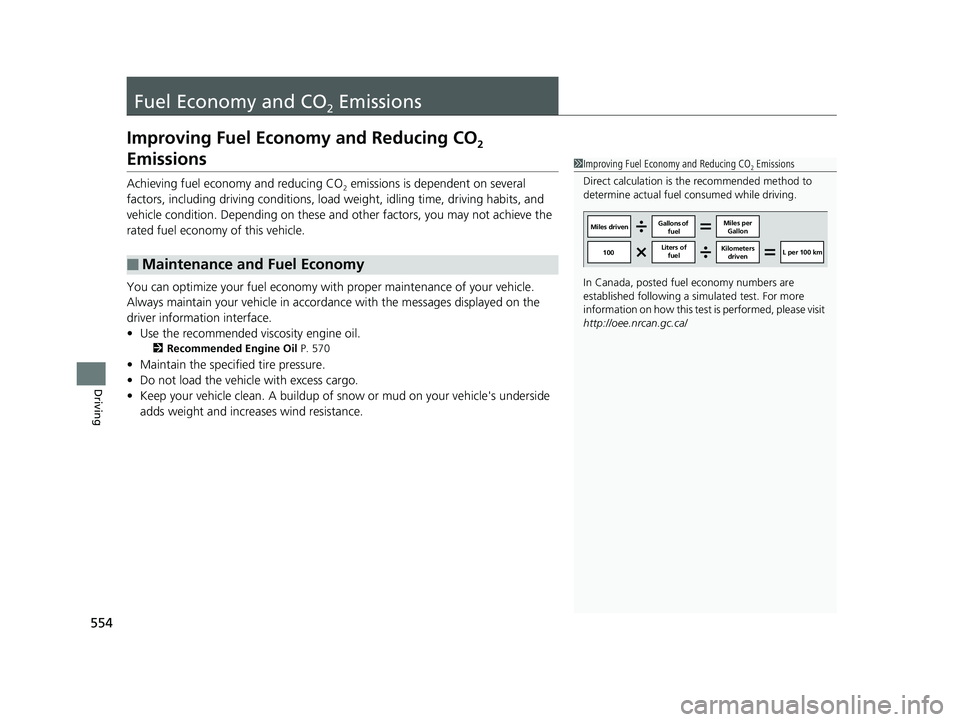
554
Driving
Fuel Economy and CO2 Emissions
Improving Fuel Economy and Reducing CO2
Emissions
Achieving fuel economy and reducing CO2 emissions is dependent on several
factors, including driving conditions, load weight, idling time, driving habits, and
vehicle condition. Depending on these and other factors, you may not achieve the
rated fuel economy of this vehicle.
You can optimize your fuel economy with proper maintenance of your vehicle.
Always maintain your vehicle in accord ance with the messages displayed on the
driver information interface.
• Use the recommended viscosity engine oil.
2 Recommended Engine Oil P. 570
•Maintain the specified tire pressure.
• Do not load the vehicl e with excess cargo.
• Keep your vehicle clean. A buildup of snow or mud on your vehicle's underside
adds weight and increases wind resistance.
■Maintenance and Fuel Economy
1Improving Fuel Economy and Reducing CO2 Emissions
Direct calculation is the recommended method to
determine actual fuel consumed while driving.
In Canada, posted fuel economy numbers are
established following a simulated test. For more
information on how this test is performed, please visit
http://oee.nrcan.gc.ca/
Miles driven Gallons of
fuel Miles per
Gallon
100 Liters of
fuel Kilometers
driven L per 100 km
19 CIVIC 5D HUM (KA KC KL)-31TGG6201.book 554 ページ 2018年10月25日 木曜日 午後4時12分
Page 560 of 699
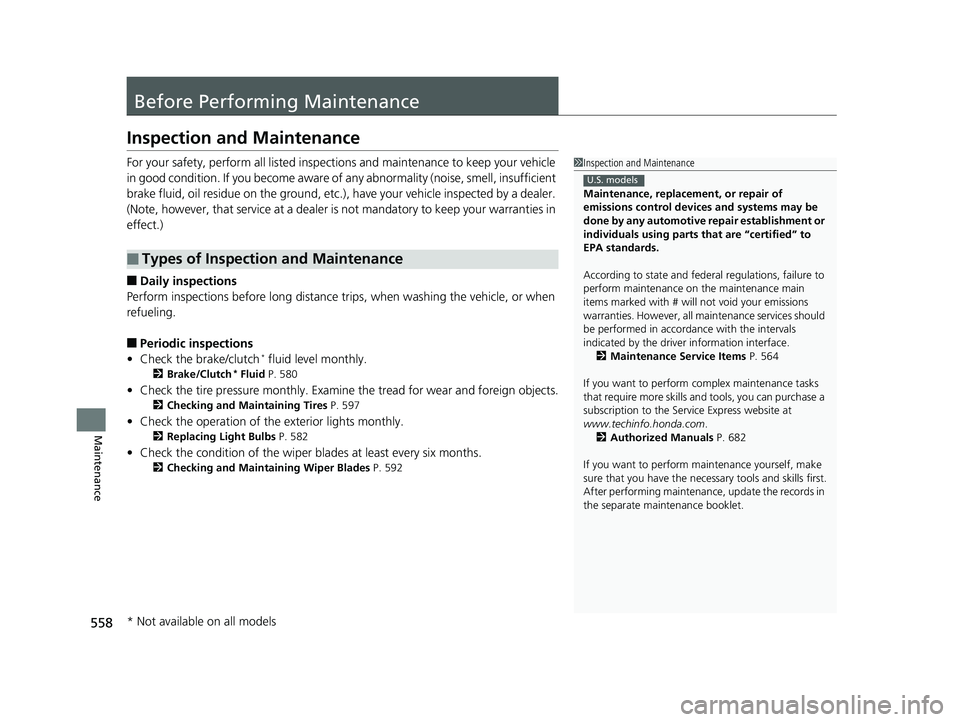
558
Maintenance
Before Performing Maintenance
Inspection and Maintenance
For your safety, perform all listed inspections and maintenance to keep your vehicle
in good condition. If you become aware of any abnormality (noise, smell, insufficient
brake fluid, oil residue on the ground, etc.), have your vehicle inspected by a dealer.
(Note, however, that service at a dealer is not mandatory to keep your warranties in
effect.)
■Daily inspections
Perform inspections before long distance tri ps, when washing the vehicle, or when
refueling.
■Periodic inspections
• Check the brake/clutch* fluid level monthly.
2 Brake/Clutch* Fluid P. 580
•Check the tire pressure monthly. Examin e the tread for wear and foreign objects.
2Checking and Maintaining Tires P. 597
•Check the operation of the exterior lights monthly.
2 Replacing Light Bulbs P. 582
•Check the condition of the wiper bl ades at least every six months.
2Checking and Maintaining Wiper Blades P. 592
■Types of Inspection and Maintenance
1Inspection and Maintenance
Maintenance, replacement, or repair of
emissions control devices and systems may be
done by any automotive repair establishment or
individuals using parts that are “certified” to
EPA standards.
According to state and fede ral regulations, failure to
perform maintenance on the maintenance main
items marked with # will not void your emissions
warranties. However, all ma intenance services should
be performed in accordan ce with the intervals
indicated by the driver information interface.
2 Maintenance Service Items P. 564
If you want to perform complex maintenance tasks
that require more skills a nd tools, you can purchase a
subscription to the Service Express website at
www.techinfo.honda.com .
2 Authorized Manuals P. 682
If you want to perform ma intenance yourself, make
sure that you have the necessary tools and skills first.
After performing ma intenance, update the records in
the separate maintenance booklet.
U.S. models
* Not available on all models
19 CIVIC 5D HUM (KA KC KL)-31TGG6201.book 558 ページ 2018年10月25日 木曜日 午後4時12分
Page 599 of 699
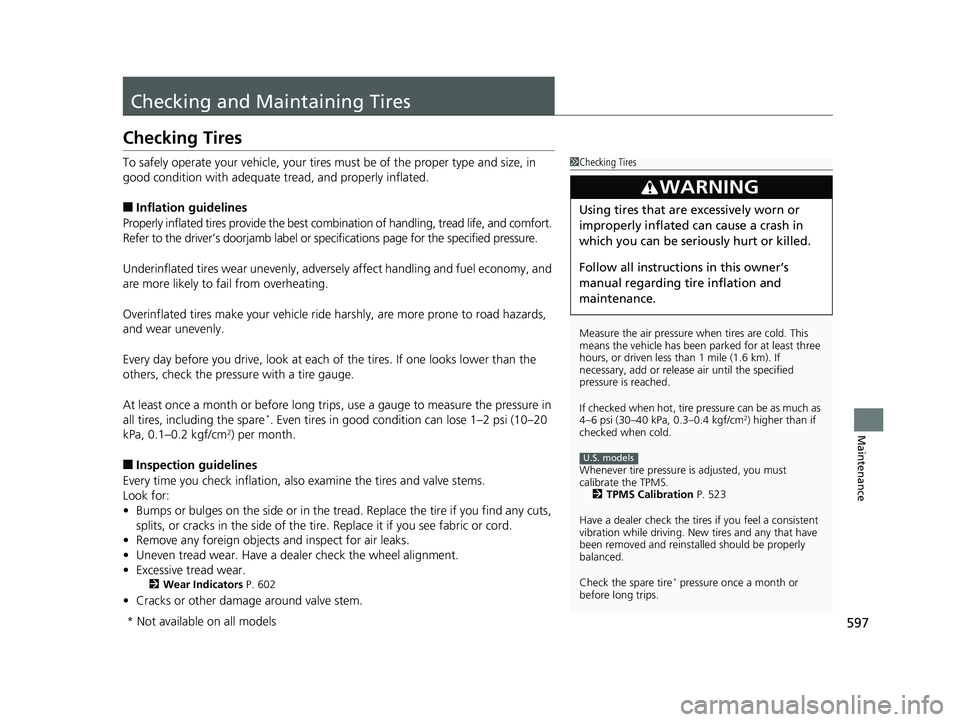
597
Maintenance
Checking and Maintaining Tires
Checking Tires
To safely operate your vehicle, your tires must be of the proper type and size, in
good condition with adequate tread, and properly inflated.
■Inflation guidelines
Properly inflated tires provid e the best combination of hand ling, tread life, and comfort.
Refer to the driver’s doorjamb label or spec ifications page for the specified pressure.
Underinflated tires wear unev enly, adversely affect handling and fuel economy, and
are more likely to fail from overheating.
Overinflated tires make your vehicle ride ha rshly, are more prone to road hazards,
and wear unevenly.
Every day before you drive, look at each of the tires. If one looks lower than the
others, check the pressure with a tire gauge.
At least once a month or before long trips , use a gauge to measure the pressure in
all tires, including the spare
*. Even tires in good condition can lose 1–2 psi (10–20
kPa, 0.1–0.2 kgf/cm2) per month.
■Inspection guidelines
Every time you check inflation, also examine the tires and valve stems.
Look for:
• Bumps or bulges on the side or in the tread. Replace the tire if you find any cuts,
splits, or cracks in the side of the tire . Replace it if you see fabric or cord.
• Remove any foreign objects and inspect for air leaks.
• Uneven tread wear. Have a deal er check the wheel alignment.
• Excessive tread wear.
2 Wear Indicators P. 602
•Cracks or other damage around valve stem.
1Checking Tires
Measure the air pressure when tires are cold. This
means the vehicle has been parked for at least three
hours, or driven less than 1 mile (1.6 km). If
necessary, add or releas e air until the specified
pressure is reached.
If checked when hot, tire pressure can be as much as
4–6 psi (30–40 kPa, 0.3–0.4 kgf/cm
2) higher than if
checked when cold.
Whenever tire pressure is adjusted, you must
calibrate the TPMS. 2 TPMS Calibration P. 523
Have a dealer check the tires if you feel a consistent
vibration while driving. Ne w tires and any that have
been removed and reinst alled should be properly
balanced.
Check the spare tire
* pressure once a month or
before long trips.
3WARNING
Using tires that are excessively worn or
improperly inflated can cause a crash in
which you can be seriously hurt or killed.
Follow all instruction s in this owner’s
manual regarding ti re inflation and
maintenance.
U.S. models
* Not available on all models
19 CIVIC 5D HUM (KA KC KL)-31TGG6201.book 597 ページ 2018年10月25日 木曜日 午後4時12分
Page 618 of 699

616
uuCleaning uExterior Care
Maintenance
Exterior Care
Dust off the vehicle body after you drive. Regularly inspect your vehicle for scratches
on painted surfaces. A scratch on a painted surface can result in body rust. If you
find a scratch, promptly repair it.
Wash the vehicle regularly. Wash more frequently when driving in the following
conditions:
• If driving on roads with road salt.
• If driving in coastal areas.
• If tar, soot, bird droppings, insects, or tree sap are stuck to painted surfaces.
• Make sure to follow the instructions indicated on the automated car wash.
• Fold in the door mirrors.
• For models equipped with automatic inte rmittent wipers, turn the wipers off.
• Keep sufficient distance between the cleaning nozzl e and the vehicle body.
• Take particular care around the windows. St anding too close may cause water to
enter the vehicle interior.
• Do not spray high pressure water directly into the engine compartment. Instead,
use low pressure water and a mild detergent.
■Washing the Vehicle
■Using an Automated Car Wash
■Using High Pressure Cleaners
1 Washing the Vehicle
Do not spray water into the air intake and hood
intake
* vents. It can cause a malfunction.
Do not spray water onto the fuel fill door directly. A
high-pressure spray ma y cause it to open.
Air Intake Vents
1.5 L engine models
Hood
Intake Vent2.0 L engine models
Air Intake
Vents
* Not available on all models
19 CIVIC 5D HUM (KA KC KL)-31TGG6201.book 616 ページ 2018年10月25日 木曜日 午後4時12分